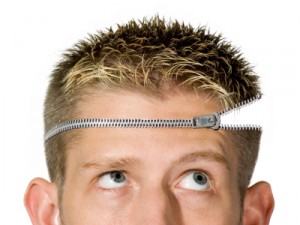How Long Does It Take (To Have A Good Idea)?

Developing a slow hunch.
Friends often ask me how long it takes to write one of my web articles. I can frame the question narrowly or broadly. In the narrow frame, the answer might be 90 minutes or so. In the broad frame, it might be 30 years or so. Talk about a slow hunch.
I’ll illustrate with my most recent article: Hate, Happiness, Imagination. As with many things – especially innovations – the article is a mashup of several different sources and concepts. Let’s track them in chronological order.
The first idea came to me through Graham Greene’s brilliant novel, The Power and the Glory. The novel includes a lovely quote: “Hate is the failure of imagination”. Greene wrote the novel in 1940, so the idea is now at least 75 years old (or perhaps older since Greene seems to echo previous authors).
I read the novel when Suellen and I lived in Guanajuato, Mexico in 1980. The quote about hate and imagination struck me and has stuck with me ever since. So, I’ve been gestating the idea for 35 years. I would occasionally mention it to friends but, otherwise, I didn’t do much with it.
In 2005, David Foster Wallace gave his famous commencement speech at Kenyon College. He stressed that, all too often, we fail to imagine what life is like for other people. If we did use our imagination more fully, we would empathize more, and our lives would be richer and fuller. First, we have to recognize that we can make a choice — that we don’t have to operate on our egocentric default setting. Second, we actually have to make the choice.
I didn’t know about Wallace’s speech until I started teaching critical thinking. As I looked for sources, I came across a video of the (abridged) speech and used it several times in my class. I first stumbled across it in 2012.
I didn’t do much with the Kenyon College speech until a few weeks ago. Frankly, I had forgotten about it. Then one of my students discovered it and asked me to show it to the class. That led to a very healthy discussion during which I connected what Wallace said to what Greene wrote.
Bingo! I made the connection between the two ideas. Why did it take me so long? Probably because I was just thinking about it. Thinking is fine but I don’t think that merely thinking creates many new ideas. The give-and-take of the class discussion stimulated me to make new connections. The diversity of opinions helped me open up new connections rather than merely deepening old connections.
Still, I didn’t have a complete thought. Then Suellen read me a paragraph from a review of the new biography of Saul Bellow. The review mentioned Bellow’s belief that imagination is “eternal naïveté”. When I realized what he meant by that, it dawned on me that it completed the thought. Greene connected to Wallace connected to Bellow.
What can we learn from this? First, this little story illustrates Steven Johnson’s idea of the “slow hunch”. Many good ideas – and most innovations – result from mashing up existing ideas. Unfortunately, we don’t get those ideas simultaneously. We may get one in 1980, another in 2012, and another last month. The trick is to remember the first one long enough to couple it with the second one. (Writing a blog helps).
The other point is that the pure act of thinking is (often) not enough. We need to kick ideas around with other people. Diversity counts. I’m lucky that I can kick ideas around with my students. And with Suellen. If not for them, I wouldn’t be nearly as interesting as I am.
So, how long does it take me to have a good idea? About 35 years.
Creativity and Sex

Hey sexy.
Why are we creative? Other animals don’t create much and yet they’re often very successful. The horseshoe crab, for instance, has been around for 450 million years. That’s a pretty good success story – I hope we humans can stick around that long. Yet nobody accuses horseshoe crabs of being creative.
Some researchers argue that creativity derives from competitive, evolutionary pressures. If we can develop creative solutions to problems, we can out-compete other animals. We might even out-compete other humans, like the Neanderthals.
Other researchers suggest that creativity has more to do with mate selection. The basic argument: creativity is sexy. Geoffrey Miller, for instance, suggests that creativity is not so very different from a peacock’s tail. It’s an advertisement to lure a mate.
If that’s true, it raises a different question: what kinds of creativity are the sexiest? Fortunately, Scott Barry Kaufmann, Gregory Feist, and their colleagues looked into that very question in a recent article (“Who Finds Bill Gates Sexy?”) in the Journal of Creative Behavior. (You can find less technical descriptions of the study here and here).
Feist had previously proposed that there are three forms of creativity and that they might vary in their degree of sexiness. In the current paper, Kauffman and Feist and their colleagues, tested this hypothesis on 119 men and 696 women using a variety of cognitive and personality tests. Feist’s three general forms of creativity are:
- Applied/technological – such as engineering projects and technical developments.
- Ornamental/aesthetic – such as the fine and performing arts, including painting, sculpture, music, and dance.
- Everyday/domestic – innovations in our daily living, including interior design or innovations in cooking, etc.
Which of the three do you find sexiest? In the study, both men and women found “… ornamental/aesthetic forms of creativity … more sexually attractive than applied/technological forms of creativity.”
Further, the sexiest creative behaviors included playing sports, playing in a band, making a clever remark, writing music, dressing in a unique style, and writing poetry. The least sexy creative behaviors included interior design, writing a computer program, creating a website, growing and gardening, creating scientific experiments, and creating ad campaigns.
In an earlier post, we learned that men who do more chores around the house have less sex than men who do fewer chores. With the new research, we now have a more complete picture of what’s sexy and what’s not. What to do? I don’t know about you but I’m going to sell the vacuum cleaner and start taking guitar lessons.
How To Have A Good Idea – Part 1
We often think that good ideas are random events. We might say, for instance, that “the idea just popped into my head” or it “just occurred to me.” We may convince ourselves that we’re not the authors of our own ideas. They just happen.
But having a good idea is really no different than any other skill. The more we practice, the better we become. We can train ourselves to create more ideas. The more ideas we produce, the more chance we have of producing good ones. As Scott Adams, the creator of Dilbert, has remarked, “Creativity is allowing yourself to make mistakes. Art is knowing which ones to keep.”
So how do you create ideas and, especially, how do you create good ones? The first step is to pay attention. We all have good ideas from time to time. Pay attention to what you’re doing when you have a good idea. Then do more of that.
With that thought in mind, I’ve asked the students in several editions of my Critical Thinking class what they were doing the last time they had a good idea. Here’s a list, in no particular order.
Taking a walk – I haven’t kept precise count but this is certainly one of the most frequently mentioned activities. It’s also my favorite. Whenever I need a good idea, I go for a walk.
Out for a run – like walking, only faster.
Going for a drive – also fairly popular and may be related to highway hypnosis.
Taking a shower – another frequent one.
Reading – this one comes up fairly often, especially reading in bed before falling asleep. As I’ve noted before, sleepy people seem more creative.
Meditation – most of my students don’t meditate but the ones who do often mention it as a time when they get good ideas.
On the subway or bus, commuting – a routine action repeated most every business day; apparently the mind wanders.
On the elevator – this was a student from New York where I gather they take long elevator rides.
Lifting weights at the gym – I suspect that System 1 is lifting the weights while System 2 is rummaging around in more interesting topics.
Dreaming – this comes up occasionally. As one student put it, “I had a fabulous idea for work and had to wake up and write it down.”
Listening to others and listening to colleagues – nobody has told me that they have a good idea when talking. A number of students have told me the ideas come when they’re listening.
Mowing the lawn – it’s a good time to let your mind wander.
Over a cup of coffee in the quiet morning before the kids get up – what a delicious time.
Sitting on the couch talking and strategizing the next day’s plan with my wife – another lovely moment.
I’m struck by how many of the idea-generating activities involve motion. We’re walking or running or driving the car or riding the subway. We’re moving through space and there’s a lot to stimulate our System 1. Yet we don’t have to do much consciously; our System 2 is free to wander. We’re daydreaming but we don’t realize it.
Many of the activities find us alone – like driving or meditating – or alone in a crowd – like riding the subway. We seem to need some stimulus but we also need to withdraw into a quiet, inner space.
Not many students have mentioned having good ideas while in a meeting. But when they do, they often mention the alone-in-a-crowd experience. They may not know many people in the meeting or they’ve mentally checked out for a while. There’s some stimulus but the mind is wandering.
It occurs to me that most of these activities are a form of meditation. We don’t think of it as such but we’re occupying System 1 with routine activities – not unlike chanting a mantra – and allowing System 2 to wander. We don’t think of ourselves as a nation of meditators but perhaps we are.
So, how about it? What were you doing the last time you had a good idea?
Crosswords, Wu-Wei, and Flow

Five letters …Chinese system of thought
Suellen and I like to do crossword puzzles together. We enjoy sorting out the wordplay and ambiguities and finding the solution. When we can’t figure out the answer, we use the same strategy but different tactics.
Our strategy might be called indirection – we move away. I’ve discovered that I often find the answer when I give up. I look at Clue #3 and can’t figure it out. So I think, “Well, I can’t get it so I might as well move on to Clue #4.” In the very brief time that it takes me to move from Clue #3 to Clue #4, the answer often comes to me. I’ve de-focused and given up when the answer simply pops into my head.
Suellen’s indirection is physical and spatial rather than temporal. We typically work at a table and we usually lean in close to the puzzle. When Suellen can’t get the answer, she stands up and looks at the entire puzzle from a distance. She sees the puzzle as a whole and spots patterns. Capturing the global nature of the puzzle helps her sort out specific clues.
In both cases, we move away. We’re no longer trying to solve a specific clue. We’re not doing rather than doing. I thought of this when I read “Trying Not To Try” by Edward Slingerland in a recent issue of Nautilus. Slingerland is a professor of Asian studies and cognition (what a great combo) at the University of British Columbia.
Slingerland describes the Daoist concept of wu-wei or effortless action. “Wu-wei literally translates as ‘no trying’ or ‘no doing’ but it’s not all about dull inaction. In fact, it refers to the dynamic, spontaneous, and unselfconscious state of mind of a person who is optimally active and effective.”
Slingerland argues that achieving wu-wei requires us to balance and integrate Systems 1 and 2. As you may recall, System 1 is our low-energy thinking system that is fast, automatic, effortless, and always on. System 1 makes the great majority of our decisions automatically — we don’t need to think about them. System 2 is the conscious energy hog that helps us think logically and provides executive task control. When we say, “I gave myself permission to have another glass of wine”, we’re essentially saying, “My System 2 gave my System 1 permission…”
Wu-wei integrates the two systems. Slingerland writes, “We have been taught to believe that the best way to achieve our goals is to reason about them carefully and strive consciously to reach them. But [wu-wei] … shows us that many desirable states are best pursued indirectly. … When your conscious mind lets go, your body can take over.”
Wu-wei also reminds me of the concept of flow described by Mihaly Csikszentmihalyi. For instance, Csikszentmihalyi writes that flow involves a stage called incubation, “…during which ideas churn around below the threshold of consciousness.” Similarly, there is an insight phase – an Aha moment. At this stage, too much focus can be self-defeating. You need to let your mind wander. You need to not try too hard.
Whether we call it wu-wei or flow or something else, it’s a remarkable concept. Trying not to try may seem contradictory but it’s worth a try. I find that taking a good long walk can help me get nearly the right balance. My body is occupied and my mind wanders. I’m not trying to do much of anything. That’s when the insights come.
Creativity Templates – 2

Pictorial Analogy
A few days ago, I wrote about the study that Jacob Goldenberg et. al. used to demonstrate the effectiveness of creativity templates. Goldenberg and his associates used several different methods to create and test ads. They found that six creativity templates – though not foolproof – consistently created better ads than alternative methods.
So what were the templates? Here they are. (Note: Some of the examples used come from the original article, others come from my experiences).
Template 1 – Pictorial Analogy – uses a picture to exemplify the product (or product attribute) in a compelling way. Two basic versions exist:
Version 1 – Replacement – in illustrating the complexity of warehouse management, we used a picture of a gumball machine filled with different colored gumballs. The picture “replaces” the warehouse and emphasizes the difficulty of getting the right inventory off the shelf and delivered to customers.
Version 2 – Extreme analogy – the picture represents something extreme about the product. For instance, running shoes that cushion the shock might be illustrated with landing gear on a space ship touching down on Mars.
Template 2 – Extreme Situation – creates an unrealistic situation to emphasize key attributes.
Version 1 – Absurd alternative – a security alarm ad shows a woman barking at intruders to scare them away. You don’t have to use our alarm system. You can always learn to bark like a dog – an absurd alternative.
Version 2 – Extreme attribute – exaggerate a product attribute to the absurd. To communicate that a Jeep can go anywhere, show it driving along the bottom of the ocean
Version 3 – Extreme worth – exaggerate the worth of a product feature to the absurd.
Template 3 – Consequences – illustrates the (exaggerated or extreme) consequences of using or not using the product.
Version 1 – Extreme consequences – at a B2B software company, we sent hammocks to a select group of CIOs to give them a place to relax after they bought our software.
Version 2 – Inverted consequences – we also sent straitjackets (real ones – very creepy) to another group of CIOs to show them how they would feel if they didn’t buy our software. Note: the straitjackets worked better.
Template 4 – Competition – the product (or attribute) is shown competing with a product from a completely different class
Version 1 – Attribute in competition – to illustrate the speed of a car, show it racing a bullet.
Version 2 – Worth in competition – not how it performs (speed) but how much it’s worth to you
Version 3 – Uncommon use – a young couple’s car breaks down. A friend offers to tow them but doesn’t have a towrope. They use the husband’s jeans as a towrope. An uncommon use that illustrates the product’s toughness.
Template 5 – Interactive Experiment – invites the viewer into an experiment which demonstrates the need for the product or service
Version 1 – Activation version – you actually engage in the experiment. For instance, you’re invited to scratch your head over a black patch in a magazine. If white flakes appear on the black patch, you need our dandruff shampoo
Version 2 – Imaginary experiment – well, imagine this …
Template 6 – Dimensionality Alteration — change the relationship between the product attribute and the environment.
Version 1 – New parameter – change an attribute in the environment to accentuate the product attribute. To accentuate the color of a shirt, create a photo in which everything is in black-and-white except the shirt.
Version 2 – Multiplication – multiply the product (or product attribute) and then compare it to something in the environment. Example: early Hyundai ads, where two Hyundais cost less than one entry-level Toyota.
Version 3 – Division – divide the product into component parts and compare them to each other and/or to the environment.
Version 4 – Time leap – present an ordinary scenario but make it interesting by shifting it to the past or future. A wife argues with her husband about why he cancelled the life insurance. Sounds ordinary, until you realize that it’s set in the future, when the husband is already dead.
Do these templates always work? Well…. no. But I can attest that they are more efficient and effective than classic brainstorming techniques where no answer is wrong and we throw everything on the white board to see what sticks. Go ahead, give ’em a try.
